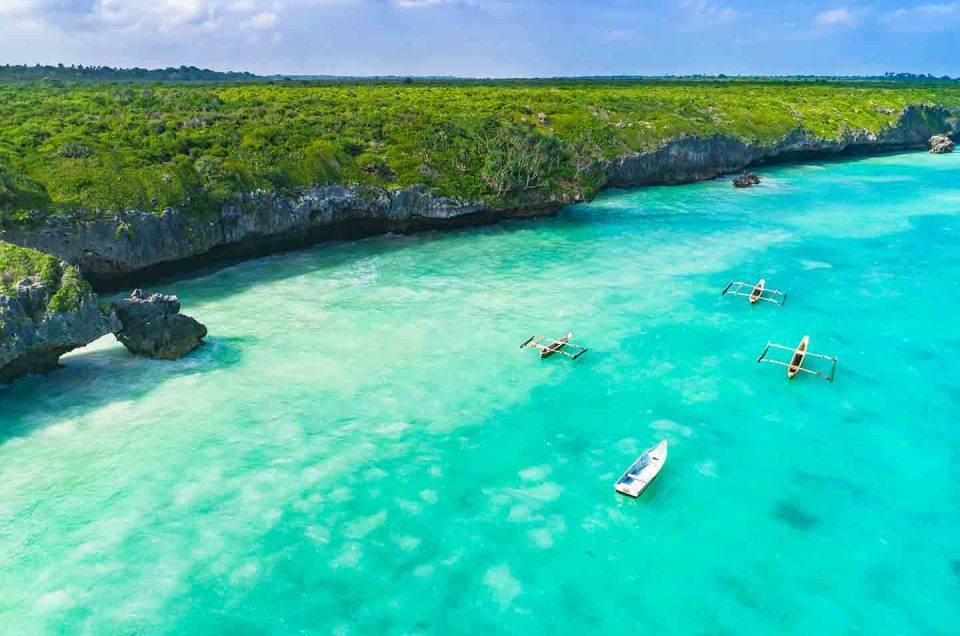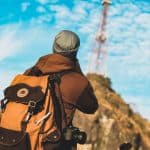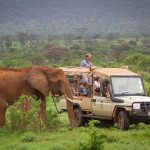Amboseli National Park
Amboseli National Park is 39,205 ha in size an ecosystem that spreads across the Kenya–Tanzania boarder. Crowned by Mount Kilimanjaro, Africa’s highest peak, Amboseli national park is one of Kenya’s most popular parks. The park is famous for its large herd of free ranging Elephants and has a mixed topography of plains, acacia woodland, rocky thorn bush, swamps and marshes. This is a true haven for nature lovers. Amboseli national park has an endless underground water supply that is filtered through thousands of feet of volcanic rock from Kilimanjaro’s ice cap which funnel into two clear water springs at the heart of the park. This
diversity along with a long dry season ensures excellent viewing of the largest concentration of African animals living in their natural habitat.
Tsavo West National Park
You will probably hear of the man eaters of Tsavo or ghost in the dark when visiting Tsavo national park. I will give you bait of a story about these beasts. In 1898, the rail line that now separates Tsavo East and Tsavo West national parks was in construction. Two lions [man eaters] apparently attacked a whole camp of workers. These attacks halted the construction of the rail. The number of people mauled was 140. Lieutenant Colonel Patterson who was at the time overseeing the rail managed to shoot and kill the two lions enabling the completion of the construction.
Tsavo West national park covers 7,065 squares with a diverse habitat of riverine forest, palm thickets, rocky outcrops, ridges, mountains and plains. The park is home to the largest population of red skinned elephants and many endangered African wildlife like the black rhinoceros, Cohengerbil, hunters heartbeats, several species of shrew rat, gravy zebra and wild dogs. Over 500 different bird species which include the white backed night hero, African skimmers and palm nut vultures have been recorded in the park making it a haven for bird lovers.
There is evidence of volcanic activities everywhere in Tsavo west national park especially where the recent lava flow absorbs the rainfall in one specific place, the Mzima springs which is located on the north of the park. This apparently happens to be the iconic attraction of tsavo west
national park. Here fish and hippos can be seen from the crystal clear water that is filtered from underground of the Chyulu hills. Don’t miss the chance of visiting the Shetani lava flows and some of the caves in the area for geological exploration.
Maasai Mara Game Reserve
Nowhere on Earth has a wildlife show like the Maasai Mara. It is one of the greatest wonders of the world in terms of animal migration. The Masai Mara game reserve is also considered a ‘must see’ by almost all visitors going on safari. This park is on the bucket list for many as it is graced
by a wide variety of unique and exquisite wildlife, birds not forgetting the enchanting culture of the Masai people.
No animal spectacle can be compared to the annual migration of wildebeests, and other antelopes from Tanzania to Kenya. Visiting Maasai Mara give you the only opportunity to see one of the world’s most amazing occurrences. This is no doubt the makers of documentaries in the natural
geographic literally camp here to get the most epic videos and pictures for their programs.
You will have to have morning and evening game drives allowing you to be one with nature, or alternatively you can opt to book a balloon ride over the Mara plains. Fly over the great Mara River, swamps, forests, wildlife and the African savanna. The quite relaxing ride allows you to view an amazing assortment of wildlife from a unique bird’s eye view. Surprise bush champagne is awaiting you upon landing. The climax of this spectacle runs from July to September as the wildebeest and other antelopes migrate from Tanzania into Kenya in their millions. The sight is so captivating that you will be left in bewilderment. The wildebeest face the most challenging
moment as they cross the Mara River. Here the Nile crocodile is always on attack mode. But their survival instincts are so strong to fear the crocodile attack. Maasai Mara game reserve is blessed with different habitats that support vast animals and over.
Samburu Game Reserve
Samburu game reserve is one of the lesser known parks despite it covering an area of 165km₂ and busting with wildlife. Situated at the southern corner of Samburu district and boarder by the Uaso Nyiro River the park has managed to retain its naturally serene and quite feeling. Uaso
Nyiro River cuts through the park and draws a huge population of the parks animals. The park is also home to the Samburu special five; Gravy Zebra, Reticulated giraffe, Somali Ostrich, Gerenuk and the Beisa Oryx. The vulnerable five have also been spotted in the park; Dater, Great Egret, white headed vulture, martial eagle and the yellow billed Ox pecker. The pancake tortoise which is a critically endangered species according to CITIES is also found in this park. Wild dog sightings are also a common attraction in this unique protected area. The reserve has recorded over 450 bird species. This is a one stop for all wildlife viewing.
Nairobi National Park
Is it not amazing that lions, rhinoceros, buffalo’s giraffe and other wild animals that we normally see on National Geographic channel are just seven kilometers away from Nairobi city?
You see, it was always presumed that for one to see these animals, then it was to be in Maasai
Mara or any other national park far away from the city and people! Not anymore. Let me introduce you to Nairobi national park. I will call it the wonder national park. The home of wild animals in the city! This is the only national park in the world with a close proximity to the Capital city. Just seven Kilometer drive from Nairobi’s central business district lies this wonder national park. Covering approximately 117.2 square kilometers, the park offers an amazing view with sky scrapers at the back drop.
Is it not wonderful to have breathtaking scenery all around you? Get the opportunity to have a close and intimate interaction with the animals such as lions, leopards, buffaloes, giraffe, zebra, and if lucky enough might just get the chance to interact with the remaining rhinos in the park.
Ensure you visit the ivory burning site, which emphasizes on the government commitment to stopping the poaching menace and stress that ivory is only worth when on the elephants
The park also has a picnic site at the southern border of the national park. This is quite a spot for crocodile and hippopotamus sighting.






